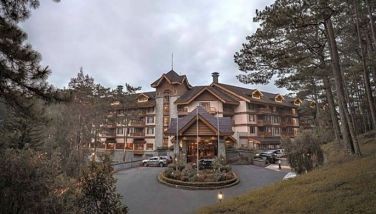The growth of Good Roots
January 27, 2003 | 12:00am
PUGO, La Union–Tree farmers here are taking the biggest gamble in their collective lives. But unlike game shows on television, they are putting in sweat as their equity and they are willing to wait between three and five years to see the fruits of their labor.
"This is not yet a prosperous town. But just wait and see," said Ramon Dumede, treasurer of Southern Cuenca Good Roots Association of barangay Cuenca at the formal launch of the third Good Roots project site of Caltex (Phils) Inc. Cuenca is one of 14 small villages targeted to participate in Good Roots III.
"Our past experience in Pagudpud, Ilocos Norte, and Lobo, Batangas resulted in the self-sufficiency of the community and the sustainability of the project," said project director and anthropologist Ben Wallace. "Here in Pugo, we found good land with good people living remarkable closer to the city than in the other project sites."
Each site presented a different challenge, owing to its different environmental and economic situation. Pagudpud and Lobo farmers, for example, were engaged in trading goods. For Pugo, there was greater dependence on cash income, being more of a transition zone between the lowlands of La Union and uplands of Baguio.
"They go to the big city to market. They need to generate more income so they have asked us to help them graft and bud calamansi and mango as cash crops. We’re going to reduce the amount of time it takes for them to make cash by growing trees for livelihood," he said.
The project promotes environmental awareness and responsibility through the creative combination of education, practice and livelihood.
"It is unrealistic to believe that nature can be returned to its pristine state but it is possible to stop the rate of destruction of the forests of the Philippines and to stabilize the rural environment," Wallace said.
To do this, the team conducts lectures and hands-on training on the proper care and maintenance of the people’s existing cultigens and plants provided by the project. Crop production technologies, harmful effects of tree cutting and income-generating activities like mushroom production are addressed at every opportunity with the community.
Acceptance and participation of targeted communities took time.
"Previous reforestation projects in these areas were on a pay-to-plant scheme. When the money was gone, the project ended. There were just different expectations," he said. "We simply work harder to convince them that they are investing in their future," he said.
Project participants are encouraged to plant short-term plants (which take six months to bear fruits), medium-term plants (which take three to five years to mature), and long-term plants (which take up to 15 years to mature).
"Farm families make non-cash contributions to Good Roots. Participants are not paid. Rather they contribute their labor in nursery development, seedlings development, and, when planting the seedlings on their lands, in stabilizing the watershed," Wallace said.
Over the past 10 years, Good Roots received P30 million from Caltex Phils. "This is our flagship environmental project. We wanted to roll into rural communities and to renew endangered environments," said corporate communications executive Marian Catedral.
The US oil company sponsored the implementation of the Good Roots project in cooperation with the Institute for the Study of Earth and Man of the US-based Southern Methodist University and the Department of Environment and Natural Resources in 1991. When Good Roots was renewed in 1997, Caltex adopted it as its own, providing funds, manpower and other forms of technical support in each site.
"Without the generous support of Caltex, Good Roots could not operate," said Wallace, who has documented the project in the book, "Good Roots II: Inheriting the Earth". The book has been distributed to corporate partners and friends to encourage duplication of similar environmental efforts.
Pagudpud farmers now care for over 43,500 seedlings distributed by Good Roots and have strived to reverse tree loss. In Lobo, the endangered Philippine teak has been given a fighting chance with an additional 250 wildings grown. Both sites have since become self-sustaining with farmers caring for their own nurseries.
For Good Roots I, the team conducted research on the Philippine ash. In Lobo, it was the Philippine teak. This third time around, the challenge lies in propagating tibig (ficus nota), a tree with fruits similar to the blackberry, from seeds, wildings and cutlings for watershed cover.
"Good Roots III is doing quite well. We now have a lot of seedlings grown from a very short time," Wallace. To date, there are 84 direct household participants. An estimated 100 households is the target for the end of the three-year project.
Requests for the project to run in other areas, including communities from Visayas and Mindanao, have reached Caltex offices. Plans for a next site are still under study.
"This is not yet a prosperous town. But just wait and see," said Ramon Dumede, treasurer of Southern Cuenca Good Roots Association of barangay Cuenca at the formal launch of the third Good Roots project site of Caltex (Phils) Inc. Cuenca is one of 14 small villages targeted to participate in Good Roots III.
"Our past experience in Pagudpud, Ilocos Norte, and Lobo, Batangas resulted in the self-sufficiency of the community and the sustainability of the project," said project director and anthropologist Ben Wallace. "Here in Pugo, we found good land with good people living remarkable closer to the city than in the other project sites."
Each site presented a different challenge, owing to its different environmental and economic situation. Pagudpud and Lobo farmers, for example, were engaged in trading goods. For Pugo, there was greater dependence on cash income, being more of a transition zone between the lowlands of La Union and uplands of Baguio.
"They go to the big city to market. They need to generate more income so they have asked us to help them graft and bud calamansi and mango as cash crops. We’re going to reduce the amount of time it takes for them to make cash by growing trees for livelihood," he said.
"It is unrealistic to believe that nature can be returned to its pristine state but it is possible to stop the rate of destruction of the forests of the Philippines and to stabilize the rural environment," Wallace said.
To do this, the team conducts lectures and hands-on training on the proper care and maintenance of the people’s existing cultigens and plants provided by the project. Crop production technologies, harmful effects of tree cutting and income-generating activities like mushroom production are addressed at every opportunity with the community.
Acceptance and participation of targeted communities took time.
"Previous reforestation projects in these areas were on a pay-to-plant scheme. When the money was gone, the project ended. There were just different expectations," he said. "We simply work harder to convince them that they are investing in their future," he said.
Project participants are encouraged to plant short-term plants (which take six months to bear fruits), medium-term plants (which take three to five years to mature), and long-term plants (which take up to 15 years to mature).
"Farm families make non-cash contributions to Good Roots. Participants are not paid. Rather they contribute their labor in nursery development, seedlings development, and, when planting the seedlings on their lands, in stabilizing the watershed," Wallace said.
The US oil company sponsored the implementation of the Good Roots project in cooperation with the Institute for the Study of Earth and Man of the US-based Southern Methodist University and the Department of Environment and Natural Resources in 1991. When Good Roots was renewed in 1997, Caltex adopted it as its own, providing funds, manpower and other forms of technical support in each site.
"Without the generous support of Caltex, Good Roots could not operate," said Wallace, who has documented the project in the book, "Good Roots II: Inheriting the Earth". The book has been distributed to corporate partners and friends to encourage duplication of similar environmental efforts.
For Good Roots I, the team conducted research on the Philippine ash. In Lobo, it was the Philippine teak. This third time around, the challenge lies in propagating tibig (ficus nota), a tree with fruits similar to the blackberry, from seeds, wildings and cutlings for watershed cover.
"Good Roots III is doing quite well. We now have a lot of seedlings grown from a very short time," Wallace. To date, there are 84 direct household participants. An estimated 100 households is the target for the end of the three-year project.
Requests for the project to run in other areas, including communities from Visayas and Mindanao, have reached Caltex offices. Plans for a next site are still under study.
BrandSpace Articles
<
>
- Latest
Latest
Latest
January 13, 2025 - 10:45am
January 13, 2025 - 10:45am
January 10, 2025 - 9:30am
January 10, 2025 - 9:30am
January 7, 2025 - 9:00am
January 7, 2025 - 9:00am
January 6, 2025 - 10:45am
January 6, 2025 - 10:45am
January 2, 2025 - 2:00pm
January 2, 2025 - 2:00pm
Recommended

























